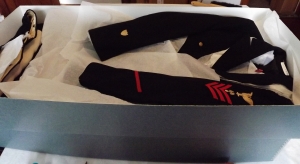The Chicamacomico Life Saving Station holds a significant number (nearly 50) of Coast Guard uniforms and accessories. While a dozen or so are on exhibit, approximately 35 uniform items have been in closets. The site’s lack of climate control and storage containers posed a threat to this collection. High RH levels exacerbated corrosion on metal buttons and invited pests. Clothes moth damage dotted many of the wool pieces. Fortunately, the local National Park Service Branch generously agreed to provide long-term storage for Chicamacomico’s uniform collection in its climate-controlled facility. NPS also purchased more than 30 large textile boxes to house the items.
 NPS Museum Curator, Christopher Price, and Cultural Resources Manager, Doug Stover, used a horsehair brush and a HEPA-filter vacuum with a screen-protected nozzle to prepare each uniform item to be boxed. Although Price used a state-of-the-art Nilfisk vacuum strapped to his back, less expensive floor-bound HEPA-filter vacuums also work well to clean textiles.
NPS Museum Curator, Christopher Price, and Cultural Resources Manager, Doug Stover, used a horsehair brush and a HEPA-filter vacuum with a screen-protected nozzle to prepare each uniform item to be boxed. Although Price used a state-of-the-art Nilfisk vacuum strapped to his back, less expensive floor-bound HEPA-filter vacuums also work well to clean textiles.

C2C's Adrienne Berney and KaeLi Schurr, Outer Banks History Center Curator, pad out a uniform jacket.
NC Department of Cultural Resources staff members recorded each item on inventory worksheets, photographed, and then boxed and padded out each garment. Thanks to funding from the NC Humanities Council, C2C was able to provide padding materials, which included unbuffered acid-free tissue, polyester quilt batting, polyester fiberfill, and stockinette. For padding out sleeves, we stuffed cotton stockinette with poly materials to make “sausage” shapes. For thinner padding layers–in pants legs, for instance–we wrapped a sheet of tissue around a double thickness of poly batting. The metal buttons on a few of the uniforms were actively corroding. In these cases, we wrapped the buttons with corrosion intercept to protect them and the surrounding textiles from further damage.
NC DCR’s Maritime Museum Registrar, Frances Hayden, got lots of practice carving ethafoam to make bases for hat mounts. She then covered the ethafoam with batting and tyvek softwrap.
She then covered the ethafoam with batting and tyvek softwrap.
To mark the uniforms for permanent storage, we followed the method outlined by Alaska Conservator, Ellen Carrlee, using a narrow tyvek tag, stitched loosely through the lining material at either end. We used acid-free, indelible ink zig millennium pens to mark tracking numbers on the tyvek. Each item will be recorded in a database created for Chicamacomico. Additionally, the Park Service will track storage locations and make the pieces available to Chicamacomico staff as needed.

ready for long-term storage at the National Park Service's Hatteras facility



Leave a comment
Comments 0